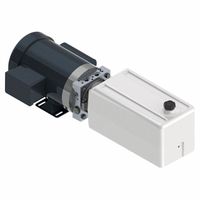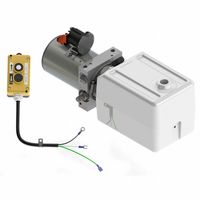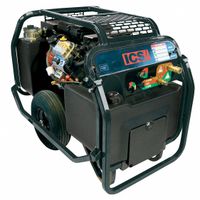Call +(254) 703 030 000 / 751 483 999 / 721 704 777
- Home
- Hydraulics
- Hydraulic Power Units
.....Read More
Frequently Asked Questions
What is a hydraulic power unit and how does it work?
A hydraulic power unit (HPU), also known as a hydraulic power pack, is a self-contained system that supplies the necessary power to drive hydraulic machinery. It typically consists of a motor, a hydraulic pump, a reservoir, and a system of valves and filters.
The motor, often electric, drives the hydraulic pump, which is responsible for converting mechanical energy into hydraulic energy. The pump draws hydraulic fluid (typically oil) from the reservoir and pushes it through the hydraulic system under pressure. The reservoir stores the hydraulic fluid and helps dissipate heat.
Valves within the HPU control the direction, pressure, and flow rate of the hydraulic fluid. These can include directional control valves, pressure relief valves, and flow control valves, each serving a specific function in regulating the hydraulic circuit. Filters are crucial for maintaining the cleanliness of the hydraulic fluid, preventing contaminants from damaging the pump and other components.
When activated, the HPU's pump sends pressurized fluid through the system to various actuators (such as hydraulic cylinders or motors) that perform work. The fluid returns to the reservoir after completing its task, creating a closed loop system. HPUs are widely used in a variety of applications, including industrial machinery, construction equipment, and material handling systems, due to their ability to generate high forces and precise movements.
What are the main components of a hydraulic power unit?
A hydraulic power unit (HPU) is a self-contained system that supplies the necessary hydraulic power to drive hydraulic machinery. Its main components include:1. Reservoir: This tank stores the hydraulic fluid. It's crucial for heat dissipation and allows contaminants to settle, ensuring the fluid remains clean and at an optimal temperature.
2. Pump: The heart of the HPU, the pump converts mechanical energy into hydraulic energy. It draws fluid from the reservoir and delivers it under pressure to the system. Common types include gear, vane, and piston pumps.
3. Electric Motor/Engine: This provides the mechanical power to drive the hydraulic pump. The size and type depend on the power requirements of the system.
4. Valves: These control the flow, pressure, and direction of the hydraulic fluid. This category includes directional control valves (to route fluid), pressure relief valves (to prevent overpressure), and flow control valves (to regulate speed).
5. Filter: Filters remove contaminants from the hydraulic fluid, protecting the components from wear and prolonging the life of the system. They are typically located in the return line or pressure line.
6. Accumulator (Optional): An accumulator stores hydraulic energy in the form of pressurized fluid. It can dampen pulsations, absorb shocks, and provide auxiliary power during peak demands or in case of pump failure.
7. Heat Exchanger (Optional): Used to control the temperature of the hydraulic fluid, preventing overheating that can degrade the fluid and damage components.
8. Gauges and Sensors: These monitor system parameters such as pressure, temperature, and fluid level, providing critical information for operation and troubleshooting.
How do you maintain a hydraulic power unit?
Maintaining a hydraulic power unit is crucial for its longevity and efficient operation. Regular fluid analysis is paramount; this involves checking for contamination, water content, and proper viscosity. Filters (both pressure and return line) should be inspected and replaced according to manufacturer recommendations or when pressure differentials indicate clogging. The hydraulic fluid itself needs to be changed periodically, adhering to the specified type and quantity.
Beyond the fluid, inspect all hoses and fittings for leaks, cracks, or signs of wear, replacing any compromised components promptly to prevent fluid loss and system inefficiency. The motor and pump should be checked for unusual noises, vibrations, or excessive heat, which can signal impending failure. Reservoir breathers should be kept clean to prevent particle ingestion. Electrical connections and wiring should be secure and free from corrosion. Finally, it's good practice to log all maintenance activities, fluid analysis results, and component replacements to track the unit's health and anticipate future needs.
What are the advantages of using hydraulic power units over other systems?
Hydraulic power units offer several key advantages over other systems, making them a preferred choice in numerous industrial and mobile applications. One primary benefit is their ability to generate immense force and torque from relatively small packages. This high power density allows for compact designs capable of handling heavy loads and demanding tasks, such as in construction equipment, presses, and manufacturing machinery.
Another significant advantage is their precise control capabilities. Hydraulic systems allow for very fine adjustments in speed, direction, and force, enabling accurate and repeatable movements. This is achieved through the use of valves and sophisticated control mechanisms, making them ideal for applications requiring high precision, like robotics or machine tools.
Hydraulic systems are also known for their durability and robustness. They can operate reliably in harsh environments, including those with extreme temperatures, dust, or moisture, due to their sealed nature and the incompressible properties of hydraulic fluid. This inherent toughness contributes to a longer lifespan and reduced maintenance compared to some alternative systems.
Furthermore, hydraulics offer excellent responsiveness and smooth operation. The immediate transmission of force through the fluid results in quick and predictable responses, while the fluid's lubricating properties ensure smooth motion and minimal wear on components. This contributes to efficient operation and reduced noise levels in many applications.
While requiring proper maintenance and fluid management, the combination of high power, precise control, durability, and smooth operation makes hydraulic power units a highly effective and versatile solution for a wide range of industrial and mobile challenges.
How do you size a hydraulic power unit for a specific application?
Sizing a hydraulic power unit (HPU) involves several key considerations to ensure it meets the specific application's requirements efficiently and effectively. First, determine the maximum working pressure needed for the application. This is dictated by the force or torque required by the actuators (cylinders or motors) and their effective area/displacement. Next, calculate the required flow rate. This depends on the desired speed of the actuators and their size. For example, a larger cylinder moving at a certain speed will require more flow than a smaller one.
Once pressure and flow are established, you can select the appropriate pump. The pump's flow rating should match the required system flow, and its pressure rating must exceed the maximum working pressure. The motor size (electric or internal combustion) driving the pump is then determined by the power required to deliver the necessary flow at the maximum pressure. This can be calculated using the formula: Power (kW) = (Flow (LPM) x Pressure (bar)) / 600.
The reservoir size is another critical factor. It should be large enough to allow for heat dissipation, accommodate oil expansion, and provide sufficient volume for the system's needs, typically 3-5 times the pump's flow rate per minute. Consideration should also be given to the cooling system, especially for applications with continuous operation or high heat generation. Filters, relief valves, and other ancillary components are then selected to ensure system cleanliness, safety, and control. Finally, always account for efficiency losses in the pump, motor, and other components, and add a safety margin to your calculations to prevent under-sizing.
What are the differences between AC and DC hydraulic power units?
AC (Alternating Current) and DC (Direct Current) hydraulic power units differ primarily in their power source, motor type, and applications.
AC hydraulic power units are powered by alternating current, typically from a wall outlet or generator. They use induction motors, which are generally more robust, efficient, and require less maintenance due to the absence of brushes. AC units are well-suited for applications requiring continuous or high-power operation, such as industrial machinery, presses, and large-scale lifting equipment. They are common in factories and environments where a stable AC power supply is readily available.
DC hydraulic power units, conversely, are powered by direct current, often from batteries, car batteries, or solar panels. They typically use permanent magnet motors or series-wound motors, which are designed for intermittent operation and high starting torque. DC units are ideal for mobile applications or situations where a portable power source is needed, such as forklifts, dump trucks, tailgates, snowplows, and marine equipment. Their compact size and ability to operate independently of a fixed power grid make them versatile for remote or mobile tasks.
In summary, AC units offer continuous power and durability for static industrial applications, while DC units provide portability and high starting torque for mobile or battery-powered operations.
How do you troubleshoot common issues with hydraulic power units?
Troubleshooting common issues with hydraulic power units involves a systematic approach. First, check the fluid level and quality, ensuring it's at the correct level and free from contamination. Low fluid can lead to cavitation and overheating, while contaminated fluid can damage components. Next, inspect for leaks, both internal and external, which can reduce efficiency and pressure.
Evaluate the pump for unusual noises or vibrations, as these can indicate wear or damage. Verify that the motor is receiving adequate power and operating within its specified range. Test the pressure relief valve to ensure it's functioning correctly and maintaining the system's pressure. Clogged filters are another common culprit, so regularly check and replace them to prevent restricted flow.
Finally, examine the electrical system, including wiring, solenoids, and sensors, for any faults or disconnections. By systematically checking these key areas, you can effectively diagnose and resolve most common issues in hydraulic power units.
What types of fluids are used in hydraulic power units?
Hydraulic power units typically use various types of fluids, primarily to transmit power, lubricate components, and dissipate heat. The most common fluid is hydraulic oil, which comes in several formulations: * **Mineral-based hydraulic oils:** These are derived from crude oil and are widely used due to their good lubricating properties, viscosity stability, and affordability. They often contain additives to enhance anti-wear, anti-corrosion, and anti-foaming characteristics.
* **Synthetic hydraulic oils:** Engineered for specific performance requirements, synthetic oils offer superior temperature stability, oxidation resistance, and fire resistance compared to mineral oils. They are often used in demanding applications where extreme temperatures or high pressures are present. Examples include polyalphaolefins (PAOs) and esters.
* **Water-based fluids:** These include water-glycol solutions and oil-in-water emulsions, primarily used in applications where fire resistance is a critical concern, such as in mining or steel mills. While offering excellent fire resistance, they typically have lower lubricity and can be more corrosive than oil-based fluids.
* **Biodegradable hydraulic oils:** Made from natural esters (like vegetable oils) or synthetic esters, these fluids are designed for environmentally sensitive applications where leakage could harm ecosystems. They offer good lubrication and performance but might have a higher cost and specific compatibility requirements.The choice of fluid depends on factors such as operating temperature, pressure, environmental considerations, safety requirements, and the specific components within the hydraulic system.
How do you ensure the safety of hydraulic power units in operation?
Ensuring the safety of hydraulic power units in operation is crucial due to the high pressures and potential hazards involved. Several measures are employed to mitigate risks. Firstly, proper design and installation are paramount, including pressure relief valves, burst disc assemblies, and robust piping systems to prevent over-pressurization and leaks. Regular maintenance is essential, involving inspections for wear and tear, fluid leaks, and component integrity. This also includes checking fluid levels and quality, as contaminated or low fluid can lead to system malfunction and overheating.
Furthermore, implementing safety interlocks and emergency stop buttons allows for immediate shutdown in hazardous situations. Guards and enclosures should be in place to protect personnel from moving parts, hot surfaces, and pressurized lines. Training for operators and maintenance personnel is vital, ensuring they understand the system's operation, potential risks, and emergency procedures. This includes proper lockout/tagout procedures during maintenance to prevent accidental startup. Finally, adherence to industry standards and regulations, such as OSHA guidelines and ISO standards, provides a framework for safe operation and helps ensure compliance with best practices.
What are the typical applications of hydraulic power units in various industries?
Hydraulic power units (HPUs) are versatile systems that convert mechanical energy into hydraulic energy, enabling the operation of various machinery across numerous industries. Their widespread adoption stems from their ability to generate immense force, precise control, and high efficiency.
In manufacturing, HPUs drive machinery such as presses, plastic injection molding machines, and metal forming equipment, providing the necessary power for shaping, cutting, and assembling products. The construction industry relies on HPUs for excavators, bulldozers, cranes, and other heavy equipment, where their robust power is crucial for lifting, digging, and demolition tasks.
Agriculture benefits from HPUs in tractors, harvesters, and irrigation systems, facilitating tasks like plowing, planting, and crop processing. In the marine sector, HPUs are integral to ship steering systems, winches, and offshore drilling platforms, ensuring reliable operation in demanding environments.
The automotive industry uses HPUs in assembly lines for tasks like robotic welding and vehicle lifts. In aerospace, they are critical for landing gear, flight control surfaces, and braking systems. Even in entertainment, HPUs power theme park rides and stage mechanisms.
Their adaptability, power density, and ability to handle heavy loads make HPUs indispensable across a broad spectrum of industrial applications.



